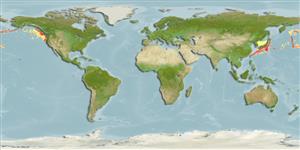>
Lophiiformes (Anglerfishes) >
Oneirodidae (Dreamers)
Etymology: Bertella: After Erik Bertelsen (1912-1993) who served as curator of the 'Dana' collections at Danmarks Fiskeri-og Havundersøgelser, Charlottenlund, Denmark. (Ref.86949).
Eponymy: Dr Erik ‘Bertel’ Bertelsen (1912–1993) was a celebrated Danish fisheries biologist and ichthyologist at the Zoological Museum of the University of Copenhagen. [...] (Ref. 128868), visit book page.
Environment: milieu / climate zone / depth range / distribution range
Sinh thái học
Biển Tầng đáy biển sâu; Mức độ sâu 805 - 3475 m (Ref. 58018). Temperate; 55°N - 14°N (Ref. 123295)
Pacific Ocean.
Bộ gần gũi / Khối lượng (Trọng lượng) / Age
Maturity: Lm ? range ? - ? cm
Max length : 10.2 cm SL con đực/không giới tính; (Ref. ); 8.4 cm SL (female); common length :559 cm TL (female)
Short description
Khóa để định loại | Hình thái học | Sinh trắc học
Các vây lưng mềm (tổng cộng) : 5 - 6; Tia mềm vây hậu môn: 4 - 5. Metamorphosed females distinguished by the following characteristics: hyomandibular bone with single head; wide ethmoid cartilage and vomer, wider than distance between anterolateral tips of lateral ethmoids and frontals; presence of vomerine teeth in juvenile, lost with growth in adults; depressed ethmoid region, narrow and oval nasal foramina; frontals long and anterior in position, overhanging and extending past the anterior limits of the ethmoid cartilage and vomer; nearly linear dorsal margin of frontals; ventromedial extensions of the frontals approach each other on midline, making contact with parasphenoid; frontals separated from prootics; presence of pterosphenoid anterior end of illicial trough is wider and shallower than posterior end; well developed sphenotic spines; well developed symphysial spine on lower jaw; well developed quadrate spine; deeply notched posterior margin of opercle; long and narrow subopercle, dorsal end slender and tapering to a point, oval ventral end; absence of first pharyngobranchial; reduced and toothless second pharyngobranchial; second hypobranchial absent; caudal fin rays without internal pigmentation; illicium longer than length of esca bulb; pterygoiphore of illicium cylindrical throughout its length, emerging on snout from between frontal bones, anterior end slightly exposed, posterior end concealed beneath skin; well developed first ray of dorsal fin; dorsal fin rays 5-6; anal fin rays 4-5; short and broad pectoral fin lobe, shorter than longest rays of pectoral fin; pectoral fin rays 18-22; coracoid lacking posteroventral process; simple pelvic bones, with or without distal expansion; skin smooth and naked, without dermal spinules; darkly pigmented skin of caudal peduncle extends well past base of caudal fin (Ref. 86949).
Also caught with plankton nets.
Life cycle and mating behavior
Chín muồi sinh dục | Sự tái sinh sản | Đẻ trứng | Các trứng | Sự sinh sản | Ấu trùng
Masuda, H., K. Amaoka, C. Araga, T. Uyeno and T. Yoshino, 1984. The fishes of the Japanese Archipelago. Vol. 1. Tokai University Press, Tokyo, Japan. 437 p. (text). (Ref. 559)
IUCN Red List Status (Ref. 130435: Version 2024-1)
Threat to humans
Harmless
Human uses
Các nghề cá:
Các công cụ
Special reports
Download XML
Các nguồn internet
Estimates based on models
Preferred temperature (Ref.
123201): 2.1 - 3, mean 2.4 °C (based on 30 cells).
Phylogenetic diversity index (Ref.
82804): PD
50 = 1.0000 [Uniqueness, from 0.5 = low to 2.0 = high].
Bayesian length-weight: a=0.01995 (0.00906 - 0.04395), b=3.01 (2.83 - 3.19), in cm total length, based on all LWR estimates for this body shape (Ref.
93245).
Mức dinh dưỡng (Ref.
69278): 3.7 ±0.5 se; based on size and trophs of closest relatives
Thích nghi nhanh (Ref.
120179): Chiêù cao, thời gian nhân đôi của chủng quần tối thiểu là dưới 15 tháng (Preliminary K or Fecundity.).
Fishing Vulnerability (Ref.
59153): Low vulnerability (10 of 100).
